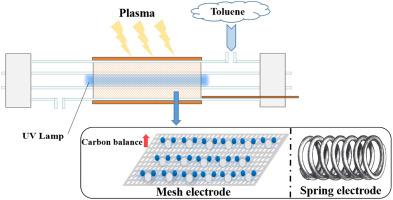Chemosphere ( IF 8.1 ) Pub Date : 2021-10-25 , DOI: 10.1016/j.chemosphere.2021.132664 Jiayao Chen 1 , Jianqi Liu 2 , Xin Liu 2 , Wenye Gao 1 , Jing Zhang 3 , Fangchuan Zhong 3

|
Combing with photo-catalysis and photo-catalyst, a surface dielectric barrier discharge (SDBD) reactor with a mesh electrode was applied for toluene degradation and a high mineralization was achieved. The degradation performance comparison between SDBD reactors with a mesh and a spring electrode was carried out as well. A significant improvement in carbon balance and CO2 selectivity were obtained in mesh SBDB reactor compared with that of spring's one. For instance, when only plasma was applied, the carbon balance and CO2 selectivity of mesh SDBD reactor were 84% and 42.6%, while only 64.5% and 31.8% in spring one, the carbon balance and CO2 selectivity were improved by 30.3% and 34% at SIE of 300 J L−1, respectively. Synergistic effects of photo-catalysis and photo-catalyst were conducted with a 254 nm UV lamp and TiO2 deposited on the mesh electrode by atmospheric pressure (AP) plasma technology. The results showed that TiO2 and UV irradiation both presented promoting effect on toluene degradation in SDBD reactor with mesh electrode. According to the experimental results, the carbon balance rose to 89.5% and 93.9% at SIE of 300 J L−1, when UV or TiO2 was applied. With the application of TiO2 and UV together, a highest carbon balance of 95.9% was obtained at the same SIE. At the same SIE, the CO2 selectivity was promoted by 42.8% or 55.3% with the application of UV or TiO2, and the promotion finally reached at 59.1% when TiO2 and UV were applied together. Additionally, the degradation efficiency of toluene was also enhanced with the introduction of TiO2 and UV irradiation. Increases in toluene degradation efficiency of 19. 7% and 26.8% were obtained at SIE of 300 J L−1, respectively. When both TiO2 and UV were applied, the enhancement could rise to 41.6%.
中文翻译:

具有网状电极的表面介质阻挡放电 (SDBD) 反应器中甲苯的降解:UV 和 TiO2 沉积在电极上的协同效应
结合光催化和光催化剂,采用网状电极的表面介质阻挡放电(SDBD)反应器降解甲苯,实现了高矿化。还进行了带有网格和弹簧电极的 SDBD 反应器之间的降解性能比较。与spring 的相比,网状SBDB 反应器在碳平衡和CO 2选择性方面获得了显着改善。例如,当只应用等离子体时,网状SDBD反应器的碳平衡和CO 2选择性分别为84%和42.6%,而在第一春时仅为64.5%和31.8%,碳平衡和CO 2选择性提高了30.3%在 SIE 为 300 JL -1 时为 34%, 分别。光催化和光催化剂的协同作用是通过大气压 (AP) 等离子体技术在 254 nm 紫外灯和沉积在网状电极上的TiO 2进行的。结果表明,TiO 2和UV照射均对SDBD反应器中的甲苯降解有促进作用。根据实验结果,当应用UV或TiO 2时,碳平衡在SIE为300 J L -1时分别上升到89.5%和93.9% 。随着TiO 2和UV的共同应用,在相同的SIE下获得了95.9%的最高碳平衡。在相同的 SIE 下,UV 或 TiO 的应用使 CO 2选择性提高了 42.8% 或 55.3%2,当TiO 2和UV一起应用时,促进最终达到59.1%。此外,TiO 2的引入和紫外线照射也提高了甲苯的降解效率。在 SIE 为 300 J L -1 时,甲苯降解效率分别提高了 19. 7% 和 26.8% 。当同时使用 TiO 2和 UV 时,增强率可以上升到 41.6%。


















































 京公网安备 11010802027423号
京公网安备 11010802027423号